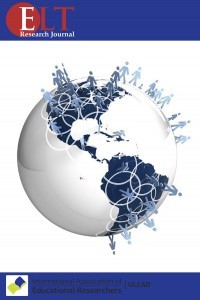A Rapid Switch from Conventional Classroom Teaching to ERT: A study on university-level EFL students’ self-efficacy and motivational levels in Turkiye amidst devastating earthquakes
A Rapid Switch from Conventional Classroom Teaching to ERT: A study on university-level EFL students’ self-efficacy and motivational levels in Turkiye amidst devastating earthquakes
ERT, online learning, self-efficacy, motivation EFL,
___
- Abdulrahim, H., & Mabrouk, F. (2020). COVID-19 and the digital transformation of Saudihigher education. Asian Journal of Distance Education, 15, 291–306. http://www.asianjde.org/ojs/index.php/AsianJDE/article/view/468 AFAD. (2023). Disaster and Emergency Management Presidency. https://deprem.afad.gov.tr/tarihteBuAy?id=79
- Agormedah, E. K., Adu Henaku, E., Ayi̇Te, D. M. K., & Apori̇ Ansah, E. (2020). Online learning in higher education during Covid-19 Pandemic: A case of Ghana. Journal of Educational Technology and Online Learning. https://doi.org/10.31681/jetol.726441
- Al Rawashdeh, A. Z., Mohammed, E. Y., Al Arab, A. R., Alara, M., Al-Rawashdeh, B., & Al-Rawashdeh, B. (2021). Advantages and disadvantages of using e-learning in university education: Analyzing students’ perspectives. Electronic Journal of E-Learning, 19(3), 107–117. https://doi.org/10.34190/ejel.19.3.2168
- Anabo, I. F., Elexpuru-Albizuri, I., & Villardón-Gallego, L. (2019). Revisiting the Belmont Report’s ethical principles in internet-mediated research: Perspectives from disciplinary associations in the social sciences. Ethics and Information Technology, 21(2), 137–149. https://doi.org/10.1007/s10676-018-9495-z
- Bandura, A. (1997a). Exercise of personal and collective efficacy in changing societies. In Self-Efficacy in Changing Societies, A. Bandura (Ed.), Cambridge University Press, London.
- Bandura, A. (1997b). Self-efficacy: The exercises of control. W. H. Freeman / Times Books / Henry Holt & Co., New York.
- Bozkurt, A., & Sharma, R. C. (2020). Emergency remote teaching in a time of global crisis due to corona virus pandemic. https://doi.org/10.5281/ZENODO.3778083 Cho, M.-H., & Cho, Y. (2017). Self-regulation in three types of online interaction: A scale development. Distance Education, 38(1), 70–83. https://doi.org/10.1080/01587919.2017.1299563
- Cohen, L., Manion, L., & Morrison, K. (2018). Research methods in education. Taylor & Francis Group. Dörnyei, Z. (2001). Motivational strategies in the language classroom. Cambridge. Cambridge University Press.
- Dörnyei, Z. (2007). Research methods in applied linguistics. Oxford: Oxford University Press. El-Sakran, A., Salman, R., & Alzaatreh, A. (2022). Impacts of emergency remote teaching on college students amid Covid-19 in the UAE. International Journal of Environmental Research and Public Health, 19(5), 2979. https://doi.org/10.3390/ijerph19052979
- Elshareif, E., & Mohamed, E. A. (2021). The effects of e-learning on students’ motivation to learn in higher education. Online Learning, 25(3). https://doi.org/10.24059/olj.v25i3.2336 Faize, F., & Nawaz, M. (2020). Evaluation and improvement of students’ satisfaction in online learning during COVID-19. Open Praxis, 12, 495–507. http://dx.doi.org/10.5944/openpraxis.12.4.1153
- Ferri, F., Grifoni, P., & Guzzo, T. (2020). Online learning and emergency remote teaching: opportunities and challenges in emergency situations. Societies, 10(4), 86. https://doi.org/10.3390/soc10040086
- Fowler, K. S. (2018). The motivation to learn online questionnaire. https://getd.libs.uga.edu/pdfs/fowler_kevin_s_201805_phd.pdf
- Gardner, R. (2010). Motivation and second language acquisition. New York: Peter Lang.
- Gerrish, K., & Lacey, A. (2010). The research process in nursing. John Wiley & Sons, Incorporated
- Hass, D., Hass, A., & Joseph, M. (2023). Emergency online learning & the digital divide: An exploratory study of the effects of Covid-19 on minority students. Marketing Education Review, 33(1), 22–37. https://doi.org/10.1080/10528008.2022.2136498
- Hodges, C., Moore, S., Lockee, B., Trust, T., & Bond, A. (2020). The difference between emergency remote teaching and online learning. Educause Review. https://er.educause.edu/articles/2020/3/the-difference-between-emergency-remote-teaching-and-online-learning
- Krippendorff, K. (2019). The logic of content analysis designs. SAGE Publications, Inc., https://doi.org/10.4135/9781071878781
- Ryan, R., and Deci, E. (2000). Intrinsic and extrinsic motivations: Classic definitions and new directions. Contemporary Educational Psychology, 25(1), 54-67. https://doi.org/10.1006/ceps.1999.1020
- Simmering, M. J., Posey, C., & Piccoli, G. (2009). Computer self-efficacy and motivation to learn in a self-directed online course. Decision Sciences Journal of Innovative Education, 7(1), 99-121. https://www.learntechlib.org/p/157700/
- Xie, Y. R., Sheng, C. X., Yang, X. T., & Wu, W. Y. (2016). The study on self-efficacy promotion effect with the application of e-learning space. Educational Technology Research [Chinese], 1, 34–40.
- Yetkin, R., & Ekin, S. (2018). Motivational orientations of secondary school EFL learners toward language learning. Eurasian Journal of Applied Linguistics, 4(2), 375–388. https://doi.org/10.32601/ejal.464202
- Yayın Aralığı: Yılda 2 Sayı
- Başlangıç: 2012
- Yayıncı: Uluslararası Eğitim Araştırmacıları Derneği
A PRINCIPLED-REVIEW OF STUDIES IN COMPUTER-BASED PRONUNCIATION INSTRUCTION FROM 2015 to 2020
A Review of Research on Mobile-Assisted Language Learning from 2016 to 2020
Ebru NOYAN, Ulaş KOÇAK, Hüseyin GÜLEÇ
THE EFFECTS OF THE USE OF BLOGS ON THE WRITING PERFORMANCES AND PERCEPTIONS OF TURKISH EFL STUDENTS
An EFL coursebook evaluation through the lens of preparatory school instructors
Muhammed Emin YÜKSEL, Reşit KÖSE, Çağrı DOĞAN
